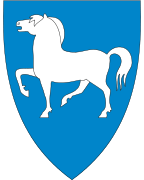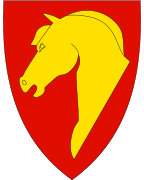Fjord horse
The Fjord horse or Norwegian Fjord Horse (Norwegian: fjordhest) is a relatively small but very strong horse breed from the mountainous regions of western Norway. It is an agile breed of light draught horse build. All Fjord horses are dun in colour, with five variations in shade recognised in the breed standard. One of the world's oldest breeds, it has been used for hundreds of years as a farm horse in Norway, and in modern times is popular for its generally good temperament. It is used both as a harness horse and under saddle.
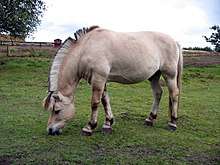 A grazing Fjord horse | |
| Conservation status | DOM |
|---|---|
| Other names | Norwegian Fjord Horse, Fjording, Fjordhest, Fjord Horse, Fjord |
| Country of origin | Norway |
| Traits | |
| Distinguishing features | Strongly built, dun coat with primitive markings, mane usually roached to stand erect |
| Breed standards | |
Breed characteristics
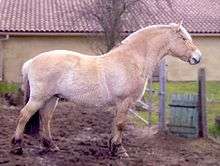
The Fjord horse has a distinct appearance. The breed's conformation differs from many other breeds in that it is a blend of draught horse muscling and bone, with smaller size and greater agility. It has a strong, arched neck, sturdy legs and good feet, and a compact, muscular body. The head is medium-sized and well defined with a broad, flat forehead and a straight or slightly dished face, with small ears and large eyes.[1] Despite its small size, the breed is fully capable of carrying an adult human and pulling heavy loads. The hair coat becomes particularly heavy and thick in the winter.
The natural mane is long, thick, and heavy, but is usually clipped in a distinctive crescent shape to between five and ten centimetres (two to four inches) so that it stands straight up and emphasises the shape of the neck.[1] This roached mane is thought to make for easier grooming. It also accentuates the horse's strong neck and full-length dorsal stripe. There is some feathering on the lower legs; however, the breed standard discourages profuse feathering.[2]
There is no upper or lower limit for height set for the breed, but heights between 135 and 150 cm (13.1 and 14.3 hands; 53 and 59 inches) at the withers are recommended.[3] [4] The weight normally ranges from 400 to 500 kilograms (880 to 1,100 lb).[1] Though some individuals may fall under the traditional cutoff between horses and ponies, the Fjord horse is considered a horse, regardless of height.
Fjord horses have a reputation for a generally good temperament.
Colour
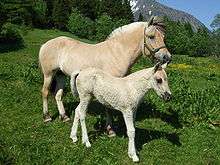
All Fjord horses are dun.[1][5] Dun is a body colour that is a tan, gold or related shade with darker (usually black or dark brown) points and primitive markings.The breed standard recognises five shade variations.[2] These shades have been officially recognised in Norway since 1922.[5] The hooves are most often dark, but can be a lighter brown colour on lighter-coloured horses.[2]
The dun colour itself is a dominant dilution gene. All Fjord horses are dun; therefore they are homozygous or nearly so for dun colouration.[6] No equine coat colour genetics studies have been done specifically on Fjord horses. But, if Fjord horses were not homozygous for the dun gene, then a dark-coloured, non-dun individual could occasionally occur in the breed. However, this is very rare or nonexistent today; dark cropouts existed in the past, but breed standardisation has favoured duns and the colour is now produced consistently.[5]
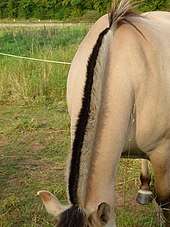
The primitive markings associated with the dun gene are often quite vivid in the Fjord horse. These include the dorsal stripe, darker mane and tail, horizontal stripes on the back of the forearms, and, in rare cases, transverse striping across the withers.[5] Some Fjord horses have small brown spots on the body or the head.[2] These spots are called "Njal marks" after one of the foundation sires of the contemporary Fjord horse, who had such markings.[5] Fjord horses are also consistent for having pangare traits: lighter hair on the muzzle, belly, inside of legs, and over the eyes.[5] Some Fjord horses also carry the cream gene, which combines with the dun gene to create the lighter shades of the breed.[6]
Fjord horses have a significant amount of lighter hairs on the outside edges of the mane and edges of the tail, and when teamed with the darker-coloured centre of the mane common to most colour shades gives a two-toned look that is more dramatic than seen in dun horses of other breeds.[7] Among Fjord horse aficionados, the dark section of hair in the middle of the mane and the darker hair in the middle of the tail, are described by the Norwegian terms midtstol and halefjær, respectively.[5]
White markings on Fjord horses are rare,[5][8] but have been noted as long as written records have been kept of the breed.[5] A small star is acceptable,[2] but any other white or pink markings are considered undesirable.[5] Norges Fjordhestlag (The Norwegian Fjord Horse Association) decided in 1982 that stallions of any age with any other white markings than a small white star cannot be accepted for breeding.[5]
Recognized shades
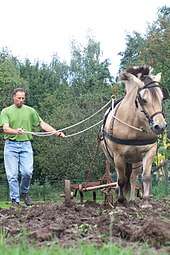
The Fjord horse breed standard recognises five colours. 90% of all Fjord horses are "brown dun" (the colour called "bay dun" in other breeds).[1] The remaining 10% are either "red dun", "grey" (less often "grey dun", the colour known as grulla in other breeds), or two colours reflecting the influence of the cream gene: "white dun" (or "uls dun") and "yellow dun".[5] The breed registries for Fjord horses encourage preservation of all colours.[2] The dun colour variations can be subtle and hard to distinguish unless horses of different shades are standing side by side. The colour terms are also non-standard when compared to English terminology more commonly used to describe horse coat colours in other breeds. This difference appears to be based in part from being derived from Norwegian language terms, which were set in 1922, and their English translations, which were made official in 1980.[5] While these terms were set before equine coat colour genetics were fully understood, the variations do match up to modern genetic studies as variations of dun colour with the addition of other genetic factors.
- Brown dun (brunblakk) is the most common color.[5] The body colour is a pale yellow-brown, and can vary from cream to almost a light chestnut. The primitive markings, as well as the midtstol and halefjær, are black or dark brown. The remainder of the mane and tail is usually cream or white, though may be a darker on darker individuals.[5] The colour is genetically bay diluted by the dun factor, called "dun", "bay dun" or "zebra dun" in other breeds.
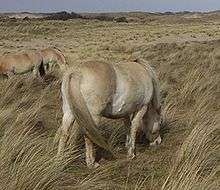
- The red dun (rødblakk) has a pale golden body colour. Midtstol, halefjær and primitive markings are red or red-brownish, always darker than the colour of the body, but never black. The rest of the mane and tail is usually cream, though on some individuals the entire mane and tail may be white.[5] Like red duns in other breeds, this shade is produced by the dun factor diluting a genetic chestnut base colour.
- The "grey" (grå) has a grey body; the shade can vary from light silver to dark slate grey. The midtstol, halefjær and primitive markings are dark grey or black.[5] The remainder of the mane, tail and forelock are a lighter grey than the body colour, and can be very pale. Though the term used in the breed standard for this colour is "grey",[2] it is actually a form of dun and not a true genetic grey. The term "grey" and even "grey dun" are misnomers, as the Fjord horse gene pool does not carry the greying gene. The term used for this colour in other breeds and by geneticists is grullo, or blue dun. Like grullos in other breeds, the "grey" body colour is produced by the dun factor diluting a genetic black base colour. The term "grey dun" or "gråblakk" is sometimes used to describe this colour, but among Fjord horse owners, that terminology is considered incorrect even if more consistent. Had English-speaking Fjord horse breeders used the same naming conventions as for their breed's other shades, the colour could genetically be called a "black dun,"[5] but this did not happen.
- The white dun or uls dun (ulsblakk) has a cream body colour. The midtstol, halefjær and primitive markings are black or off-black. The rest of the mane and tail are lighter than the body colour.[5] The colouration is genetically a bay-based dun further diluted by a single allele of the cream gene, what is sometimes called a "buckskin dun" in other settings.[6]
- The yellow dun (gulblakk) is the rarest colour of Fjord horses.[5] It is a red dun with an additional dilution factor that makes the body a light cream colour. This also due to the cream gene.[6] The forelock, mane and tail can be completely white, and the primitive markings can be indistinct.[5]
Kvit, "white"
Along with the recognised five shades of dun, two cream dilution alleles (CCr) on any other colour results in a horse with a light cream coat colour and blue eyes. This colour is called "kvit" ("white") in Norwegian, and is known as cremello, perlino or smoky cream in other breeds. A dun with double cream dilution will have faint or indistinguishable primitive markings.[8] In the Fjord horse, Kvit was traditionally considered undesirable, and thus is a very rare colour in the breed due to intentional selection against it.[8] Nonetheless, it is a normal colour within the gene pool, as the nature of cream genetics statistically will result in the occasional kvit horse any time two horses that both carry a single copy of the cream dilution are mated, such as an ulsblakk and/or a gulblakk.[6]
History
The Fjord horse is one of the world's oldest and purest breeds, believed to be related to the Przewalski, a primitive wild horse of Asia[4]. Horses were known to exist in Norway at the end of the last ice age. It is believed that the ancestors of the modern Fjord horse migrated to Norway and were domesticated over 4,000 years ago. Archaeological excavations at Viking burial sites indicate that the Fjord horse type has been selectively bred for at least 2,000 years.[1][4] The Fjord horse was used by the Vikings as a war mount. The Fjord horse and its ancestors have been used for hundreds of years as farm animals in western Norway. Even as late as World War II, they were useful for work in mountainous terrain. Its strength, durability, and thick coat fare well in the rough winters of Denmark.[4]
The Fjord horse also has a long recorded history of pure breeding without crossbreeding from other sources.[4]
The Fjord horse is featured as a charge on the coat of arms of the municipalities of Gloppen and Eid, both in Nordfjord.
Uses
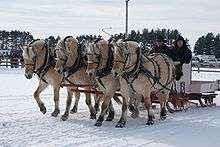
The Fjord horse is strong enough for heavy work, such as plowing fields or pulling timber, yet light and agile enough to be a good riding and driving horse. They are also sure-footed in the mountains. Today, the Fjord horse is a favourite at Norwegian riding and therapeutic schools, as its generally mild temperament and small size make it suitable for children and disabled individuals. They are considered very good driving horses, and are commonly used in everything from competitions to tourist transport in Norway. They are also used as a sport horse, particularly in combined driving.
Registries
- USA Norwegian Fjord Horse Registry (NFHR)
- Canadian Fjord Horse Association (CFHA).
- Belgisch Fjordenpaardenstamboek - Belgium 's Fjord Horse Studbook
- Fjordhesteavlen i Danmark - Denmark's Fjord Horse Studbook
- Fjord horse National Stud Book Association Of Great Britain
- Norges Fjordhestlag
- Norsk Hestesenter
- Svenska Fjordhästföreningen -Sweden's Fjord Horse Studbook
- Fjordpferde Vereinigung Schweiz - Switzerland's Fjord Horse Studbook
- Het Nederlandse Fjordenpaarden Stamboek - The Dutch Fjord Horse Studbook
- Interessengemeinschaft Fjordpferd (IGF) e.V. - The German Fjord Horse Association (IGF)
- Suomen Vuonohevosyhdistys ry - Finska Fjordhästföreningen rf (Finland)
See also
References
- "About the Breed", published by Norwegian Fjord Horse Registry. Web site accessed 7 December 2009
- NFHR Breed standard accessed 3 December 2009
- Styret i Norsk Hestesenter (7 June 2020). Avlsplan for fjordhest Old link archived: Archived 21 October 2014 at the Wayback Machine (in Norwegian). Norsk Hestesenter. Accessed October 2014.
- Breeding plan in Norway (7 June 2020) Fjord Horse International Association Old link archived: Archived 29 September 2007 at the Wayback Machine, accessed 7 December 2009
- "The Colours of the Norwegian Fjordhorse", accessed 23 January 2012
- Sponenberg, Phillip. "Color in Fjord Horses". Norwegian Fjord Horse Registry. Retrieved 20 January 2010.
- "Breed Standard". Norwegian Fjord Horse Registry. Retrieved 28 May 2017.
- Norwegian Fjord horse at horse-genetics.com, accessed 4 December 2009]
| Wikimedia Commons has media related to Fjord horse. |
